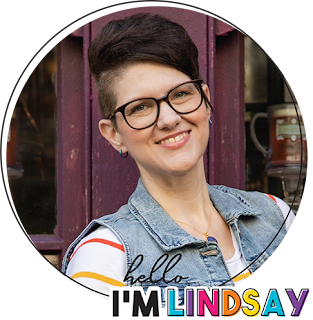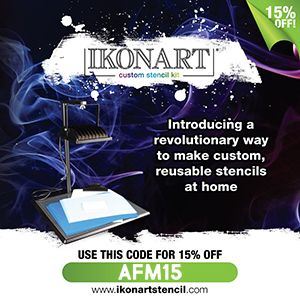Take a planter from drab to fab with this Stenciled Succulent Planter Pot tutorial!

Even though it's currently snowing outside, it's officially spring. My plant-keeping skills aren't really the best, but I do have a knack for making their homes (aka planters) look pretty great! To bring some spring-like energy into my home, I used my Ikonart Stencil Kit to give a boring concrete planter an incredible makeover. This is a great project for stencil beginners, and I'm sharing the design for FREE! I absolutely love how this planter turned out, and have been so excited to show you how I did it!
New to making reusable stencils? Here's how to Get Started with Ikonart!

To make your own Stenciled Succulent Planter Pot, you will need these supplies:
- "You Grow Girl" Design (for personal use only)
- Ikonart Custom Stencil Kit
- Cup Cradle
- 4-Inch Concrete Planter
- Paint Brush
- Chalk Paint (or Acrylic Paint) - 3 shades of one color, white
- Squeegee
- Detail Brush (optional)
*Save 15% on Ikonart supplies when you shop with code AFM15
Printables and cut files from Artsy-Fartsy Mama are for personal use only. You may use these files for personal projects, but you may not sell them. If you'd like to share this project digitally, share a link to this post/website only. Do not share a direct link to the file.

To make a stencil, you need to start with a printed design. Download the "You Grow Girl" design (for personal use only) and print the design as dark as possible on either inkjet or laser Ikonart Printer Film.
The next step in the process is exposing the stencil film. Set up the exposure stand with UV LED Light by following the directions included in the kit. Ikonart Stencil Film is light sensitive, so be careful to keep it out of sunlight and bright lights before exposure. Cut a piece of the film the slightly larger than the design print.
Lay the piece of film down on the base of the stand with the textured side facing up. Place the printed design on top of the stencil film, making sure it's right-side up - meaning that you should be able to read the words printed on the design.
Lastly, place the clear exposure sheet (found in the stencil film pack) on top and press it down well to seal the design tight against the stencil film. Turn the exposure light on and expose the film for 35 seconds.

The coolest step in the stencil-making process is to washout, or rinse the stencil. Clip the exposed stencil film to the Ikonart clipboard with the shiny side (carrier sheet) touching the clipboard. Use the kitchen sink sprayer to rinse the stencil film with warm water until the design shows through and becomes completely clear. The washout process shouldn't take more than 3 minutes.
Gently blot the excess water from the stencil, and hang or lay the stencil flat to dry for about 45 minutes. When the stencil is dry, you shouldn't see any water spots or discoloration. Once the stencil is completely dried, place the it back on the exposure stand and expose it again for at least 2 minutes without the clear cover sheet. This extra exposure time will increase the durability of the stencil so you can get as much use out of it as possible.
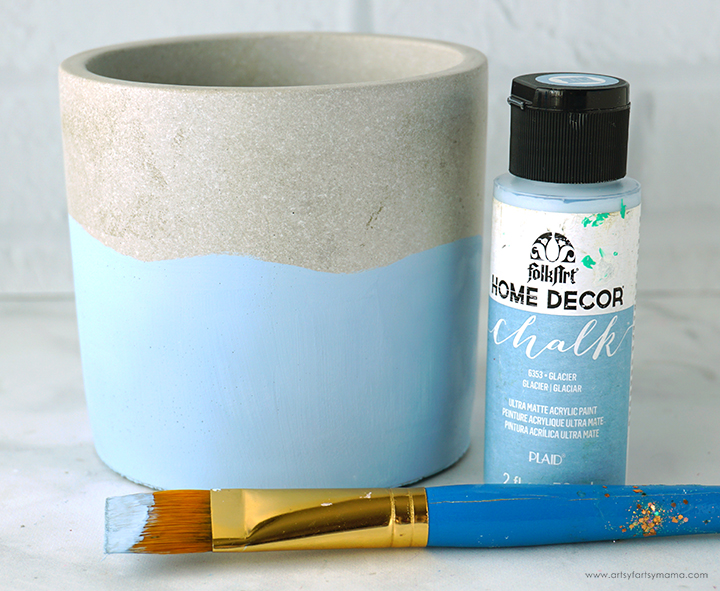
While the stencil is drying, it's time to paint the concrete planter. I would recommend using three shades of one color, or three coordinating colors of chalk paint or acrylic paint to make this design look its best. I chose blue to match my craft room.
For the first layer, use the lightest shade of paint - I used a light blue chalk paint ("Glacier"). Paint about half of the planter, but make the top edge of the paint a little bit wavy. If you need to add more than one coat, be sure to let the first coat dry completely before adding another. When the paint is on too thick, it may not completely dry or can crack.
Let this first layer of paint dry completely before moving on to the next step.

For the second layer, use a darker shade. I used chalk paint in "Provincial Blue". Imagine the painted area is split into thirds. Start at the bottom edge of the planter, and paint up until the "2/3" mark. Give the edge of the paint a wavy look similar to the top, but make it random and different than the first layer.
As a reminder, let the first coat dry completely before adding another. Also make sure to let this second layer of paint dry completely before moving on to the next step.
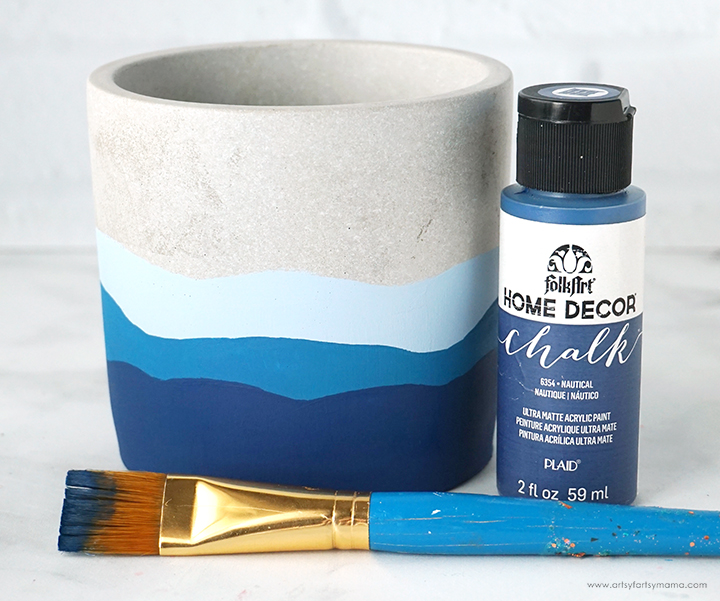
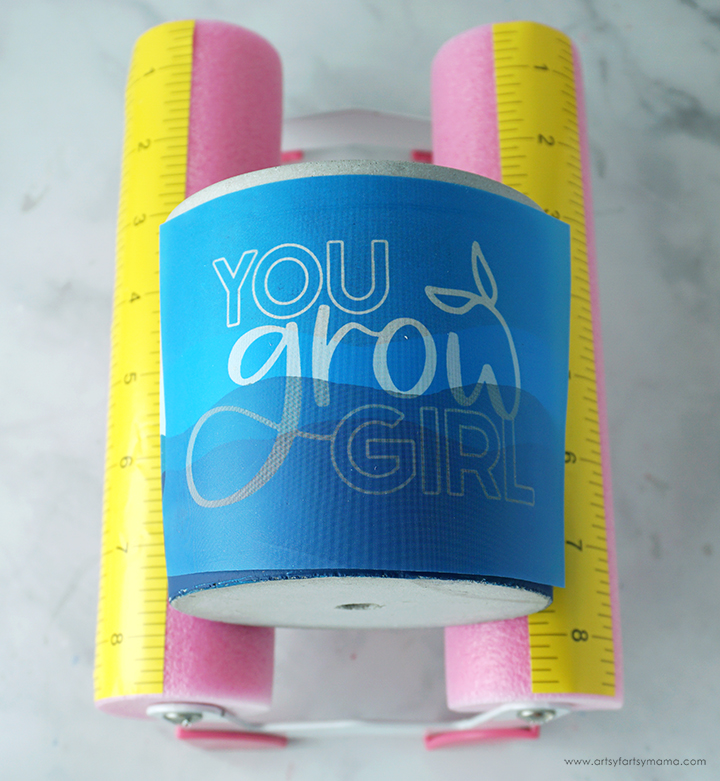
IMPORTANT: Make sure that the paint is COMPLETELY dry before moving on to this step. If it's not, your stencil could stick to it permanently and ruin your project!
Remove the clear backing from the stencil and center the design on the front of the concrete planter. Once the stencil is in place, rub it down well. To keep your planter from rolling around while you work, I highly recommend using a cup cradle!

Add a thin line of white chalk paint* at the top or bottom of the stencil (but not near the edge), and use the squeegee to lightly pull the paint over the stencil. Make sure all of the open mesh spaces of the stencil are covered evenly. Scrape away any excess paint and put it back into the paint bottle.
*If you don't have chalk paint, you can thicken some white acrylic paint with Chalk Paint Powder instead.

Carefully pull the stencil away to reveal half of the design. If you see any spots that have been missed while removing the stencil, carefully lay it back down and add a little more paint. Slowly peel the stencil up again, and repeat as necessary.

If you notice a missed spot after removing the stencil, DO NOT put the stencil back on! Wash the stencil (see below) before fixing the project so that the paint doesn't dry over the stencil mesh. If the paint dries on the stencil, it can make it hard to clean and reuse it.
To fix any mishaps, grab a small detail paint brush. If it's a missed spot of the stencil design, use the detail brush to carefully go over the area with the same paint used on the stencil. If you have an area that has bled, you can use a craft knife to carefully scrape the excess paint away while it's still wet, or use the brush to paint over the bleed with the background color (as seen in image above).
To wash your stencil so that it can be used again and again, first get the clipboard wet so your stencil doesn't stick to it. Place the stencil on the clipboard with the textured side up, and lightly rub the stencil under cold running water to remove all the paint.
Do not rub or scrub the adhesive side of the stencil, and NEVER use anything other than water to wash the stencils. To prevent the stencil from breaking down, don't ever leave the stencils to soak.
Remove the stencil from the clipboard and lay it down with the adhesive side up. While the stencil is still wet, place the carrier sheet onto the stencil so that the word “BACK” is readable. Hang or lay the stencil flat to dry completely.


I absolutely LOVE how this Stenciled Succulent Planter Pot turned out!! It was so simple to make, and it will definitely be a statement piece of decor. I'd love to hear what you think about this project, or if you want to know more about reusable stencils. If you've made your own stenciled projects, I would love to see your creations! Share them on Instagram, Facebook, or leave a comment/photo on the project pin on Pinterest! #AFMCrafts
Don't forget to Pin, Like, and Share!


